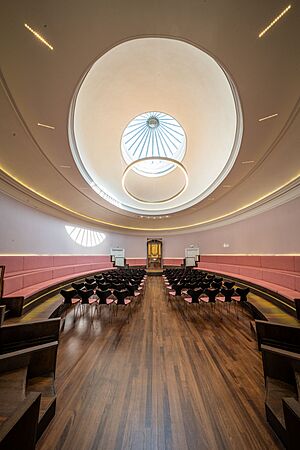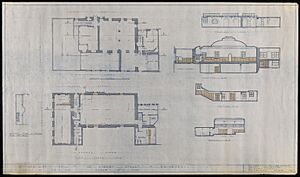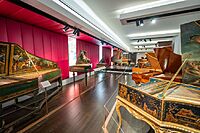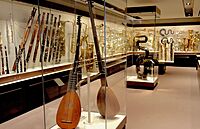St Cecilia's Hall facts for kids
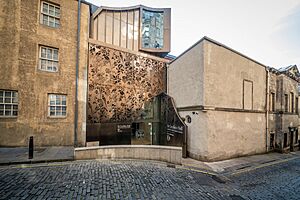
The entrance to St Cecilia's Hall on Niddry St
|
|
| Lua error in Module:Location_map at line 420: attempt to index field 'wikibase' (a nil value). | |
| Established | 1763 |
|---|---|
| Location | Edinburgh, Scotland |
| Type | Music museum, concert hall |
| Collections |
|
| Architect | Robert Mylne |
| Owner | University of Edinburgh |
|
Listed Building – Category A
|
|
| Designated | 14 December 1970 |
| Reference no. | LB27760 |
St Cecilia's Hall is a special place in Edinburgh, Scotland. It is both a small concert hall and a museum. You can find it near the Royal Mile, a famous street in the city.
This historic building first opened in 1763. It was the very first concert hall built just for music in Scotland. Today, it is owned by the University of Edinburgh. The hall is home to amazing collections of old musical instruments. These include the Russell Collection and others. People still come here to enjoy classical chamber music concerts. It is also a popular spot during the Edinburgh International Festival in summer.
Contents
The Hall's Story: A Look Back in Time
St Cecilia's Hall was built a long time ago, in 1763. A group called the Edinburgh Musical Society (EMS) wanted a new place for concerts. They asked a Scottish architect named Robert Mylne to design it. Mylne also designed the famous Blackfriars Bridge in London.
The EMS had been around since 1728. Before the new hall, they met in a small church. When the new hall was ready, they held a special concert. It honored Saint Cecilia, who is known as the patron saint of musicians.
Scotland's First Concert Hall
St Cecilia's was the first building in Scotland made just for concerts. It was built soon after the first one in Europe, the Holywell Music Room in Oxford, England. Mylne designed the hall with an oval concert room upstairs. Downstairs, there was a room for rehearsals.
Changes Over the Years
In the late 1700s, Edinburgh built a large bridge called South Bridge. This bridge changed the area around St Cecilia's Hall. The hall lost its original entrance courtyard. The new bridge and tall buildings made the area darker. Many concert-goers started going to a new, more fashionable hall in another part of the city.
Because of this, fewer people came to St Cecilia's Hall. The Edinburgh Musical Society stopped holding concerts in 1798. By 1801, the society closed down. They sold the hall to a church group.
New Uses for the Building
Over the years, the building was used for many different things. In 1821, it hosted the first chemistry lecture for the Edinburgh School of Arts. This school later became Heriot-Watt University.
The hall was also used by Freemasons, as a warehouse, and even as a school. Later, it became a ballroom. Finally, in 1959, the University of Edinburgh bought the building.
The Hall's Design and Updates
The outside of St Cecilia's Hall looks simple and classic. Inside, the main concert room is called the Sypert Concert Room. It has a unique oval shape. The ceiling is domed and has an oval glass dome in the middle.
Modern Renovations
The university has worked to keep the hall in great shape. In 1966, they hired an architect to rebuild parts of the inside. The hall reopened in 1968.
More recently, in 2016, St Cecilia's Hall had a big renovation. This project cost £6.5 million. It made the concert hall and museum even better for visitors. The hall reopened to the public in 2017.
A Museum of Musical Instruments
Besides being a concert venue, St Cecilia's Hall is also a fascinating museum. It is open to visitors from Tuesday to Saturday. Here, you can see many historic musical instruments. These instruments come from important collections like the Rodger Mirrey and Russell Collections. You can also see instruments from the Anne Macaulay Collection.
What You Can See
The museum has more than 500 instruments! They work hard to keep these old instruments safe and in good condition. You can see many types of keyboard instruments, like harpsichords, virginals, and fortepianos. There are also organs, harps, lutes, and guitars.
One special instrument is a chamber organ built around 1750. It was bought for the hall in 1967. After some repairs, it was fully restored in 2017 and can be played again.
Images for kids
See also
- Listed buildings in Scotland
- Reid Concert Hall
- List of music museums


